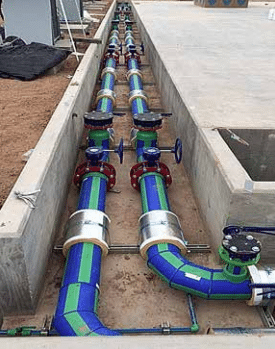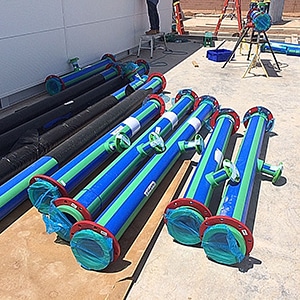ARIZONA PUBLIC POWER UTILITY PICKS AQUATHERM PIPE FOR PILOT DATA-CENTER PROGRAM
A mechanical contractor used aquatherm’s unique heat-fusion welding method to build a leak-free piping system and a McElroy DataLogger to ensure each connection was fused properly.
The Challenge
A pilot modular data-center program needed a leak-free, chilled-water piping system to keep its expensive IT equipment cool and safe.
The Solution
A pilot modular data-center program needed a leak-free, chilled-water piping system to keep its expensive IT equipment cool and safe.
PCs, laptops, tablets, smart phones, digital TVs—a great deal of energy is consumed connecting the public to the Internet. In fact, the information- communications-technologies ecosystem, also known as the digital economy, uses more than 1,500 terawatt-hours of power per year or about 10% of the world’s total electricity generation. Additionally, expending this major amount of energy on the World Wide Web produces a mountain of data to be stored. The International Data Corp. forecasts we will generate 44 zettabytes (or 44 trillion gigabytes) of digital data by 2020.
communications-technologies ecosystem, also known as the digital economy, uses more than 1,500 terawatt-hours of power per year or about 10% of the world’s total electricity generation. Additionally, expending this major amount of energy on the World Wide Web produces a mountain of data to be stored. The International Data Corp. forecasts we will generate 44 zettabytes (or 44 trillion gigabytes) of digital data by 2020.
The leadership at Tempe, AZ-based Salt River Project (SRP), the nation’s oldest—and one of its largest—public power utilities, felt it was imperative they do their part to answer the big questions related to these problems: Where can we stash all of this generated data? And, in turn, how can we decrease the amount of energy used to contain it?
SRP teamed with BaseLayer Technology from Chandler, AZ, to create the SRP DataStation, a first-of-its-kind, next-generation modular data-center infrastructure installed at an existing electric substation in Gilbert, AZ. Connecting the data center directly to the electric grid provides consumers with an unprecedented source of expansive, reliable power and enables local economic development while eliminating the need for extensive overhead power lines.
On the sustainability side, SRP is powering the data center with 100% renewable energy through its Renewable Energy Credit program, which is available to all of SRP’s commercial customers. BaseLayer’s modular technology also has demonstrated efficiency, reducing energy consumption by 19% compared with traditional raised-floor data-center environments.
Additionally, using a modular data-center design saves precious time and money. “Instead of building large, new infrastructures, we’re able to put modular data centers in place within four months of a signed contract. Modular designs reduce project turnaround,” said Robert Fitts, Senior Project Manager at Chandler-based Total Facility Solutions U.S., the mechanical contractor on the pilot SRP DataStation project and a member of UA Local 469. “Also, 50% of a data center’s total costs are saved with a modular design.”
Keeping Data Centers Cool

While of utmost importance to the world’s collective knowledge base, data centers certainly aren’t indestructible. At the mercy of everything from Mother Nature to human error, one of the most calamitous dangers to data centers is heat. Data centers house servers, and servers generate heat; the more servers a data center contains, the more quickly it warms up and the greater threat of overheating. Most data centers operate between 68˚F and 72˚F—55˚F at minimum and approximately 80˚F at maximum. Therefore, a first-rate cooling system is critical to a data center’s health and life span.
Although data centers generally can be cooled in a number of ways, including via computer-room air-conditioning (CRAC) units, aisle containment, free-air cooling, in-row cooling and airflow monitoring, liquid-cooling systems provide a much higher heat-dissipation capacity: Water is 3,467 times more efficient than air at removing heat. Because they are more efficient, liquid-cooling systems tend to use less energy than air-cooling systems because they are more energy efficient. Liquid cooling also eliminates thermal stratification, which occurs in air-cooling systems when cold air falls to the bottom of the server rack and hot air rises, increasing air-intake temperatures and, again, energy consumption. Finally, liquid-cooling systems don’t demand raised floors or noisy fans.
However, one of the biggest detractions to liquid-cooling systems is the fear of piping failure. If the pipes spring a leak, the resulting mess will be more than a nuisance. The best way of allaying this fear is specifying a leak-free piping system.
aquatherm Proves A Fast, Safe Choice
Initially, carbon steel was considered for the SRP DataStation’s chilled-water piping system. However, Fitts was interested in a better solution. “I was looking for ideas for a quicker turnaround,” Fitts said.
Steel piping is prone to corrosion and rust, and contaminants are detrimental to the health of servers, computers and other IT equipment. Steel can cause condensation concerns, and data centers are no place for dripping water or extra humidity. Large steel pipes also are extremely heavy, can slow workers down, cause injuries on the job and require heavy and expensive machinery for installation.
Additionally, traditional materials use foreign substances—such as solder—or mechanical connections to secure the piping system’s joints, but these mechanical connections can fail prematurely. The process of welding or soldering steel piping introduces fumes and particles into the data-center environment; open flames might set off fire alarms and sprinkler systems, resulting in potentially catastrophic problems for the data center.
Ultimately, Fitts requested quotes on carbon-steel piping as well as aquatherm polypropylene-random (PP-R) piping from the local P/HVAC distributor. Although Fitts had not yet used aquatherm piping systems on a project, he had heard enough to know that a heat-fused piping system could provide many advantages in this critical application.
“I knew that the aquatherm piping system itself is very light, and heavy equipment isn’t required for fabrication,” Fitts said.
By using aquatherm’s Quick Check Estimator, which gives an estimate of the total installed costs for a project, including material, labor, and tooling, Fitts was able to see how much aquatherm could save on the project’s total installed cost.
“The fabrication labor savings was definitely a plus, and the 10-year warranty was attractive,” Fitts added. “I was pretty much sold on the aquatherm.”
LONG-LASTING PIPE FOR A LEAK-FREE SYSTEM
In February 2015, Fitts and his team began working on the SRP DataStation project. While the 140-ft x 60-ft job site has room for four data-center modules, only one was installed. In March, Fitts and four of his team members were trained on aquatherm’s heat-fusion process.
aquatherm piping uses reliable heat fusion to form connections; heat fusion bonds both sides of a joint into a single, homogenous material without the use of chemicals, adhesives or mechanical connections, which eliminates systematic weaknesses and potential fail-points in the pipe. The seamless heat-fusion connections, combined with the piping’s resistance to corrosion and abrasion, help to ease leakage concerns.
TFS is no stranger to the heat-fusion welding technique, which it uses with high-density polyethylene (HDPE) in its fabrication shops all over the country. Therefore, its staff of certified welding personnel quickly adapted to the fusion process.
“Fabrication time takes too long with carbon steel,” Fitts said. “And there are no fumes associated with aquatherm like there is with carbon steel.”
Through preplanning and training, the distributor and McElroy, the fusion-tool manufacturer, helped Fitts identify the optimal number of tools needed to work at maximum efficiency during fabrication. Fitts rented two McElroy DynaMc 250 EP Fusion Machines to fabricate the data center’s chilled-water piping system. Fitts used approximately 630 ft of 8-in. and 40 ft of 6-in. aquatherm blue® with a SDR 17.6 as well as 70 ft of 3-in. blue with a SDR 11 for the chilled-water system.
Long-lasting aquatherm blue is specifically engineered for hydronic heating and cooling, industrial, geothermal and compressed-air applications. All of aquatherm’s PP-R piping systems are made of chemical-free, chemically stable thermoplastic that is non-corroding, so it won’t break down, weaken or scale like metallic piping systems. aquatherm’s PP-R won’t react with water and is highly resistant to most chemicals. Corrosion, scale and degradation are the most common culprits in piping failures. Fitts also appreciated that PP-R piping systems don’t require chemical maintenance.
The interior of a carbon-steel piping system has to be treated with chemicals to slow down corrosion and breakdown. Although the metallic equipment in any system needs treatment, aquatherm piping systems do not, which can lead to long-term savings for the end user. The required treatment may be much less than an all-steel system, which can help provide savings. And while aquatherm piping systems have a life expectancy of 50-plus years, metallic systems can be replaced as often as every five to 30 years after installation because of corrosion and scale.
Because aquatherm’s heat-fusion bonds do not require flames or produce fumes or gases, Fitts and his team were able to fabricate the majority of the piping system in their shop within two-and-a-half weeks. “Ninety-six percent of the piping system was fabricated in our shop,” Fitts said. “Using aquatherm definitely improved our schedule considerably.”
It took approximately five days to install the piping system once it was delivered to the job site.
At the site, Fitts and his team installed two new Trane 100-ton, air-cooled chillers; chilled water exits the chillers into the piping at 45˚F. The piping was installed in an underground trench; it surrounds the facility’s footprint in a complete loop system designed to feed each module’s cooling blocks. Multiple isolation valves were installed to ensure continuous piping-system operation.
“The intent is concurrent maintainability of the system,” Fitts said. “At any given time, if a section were to fail, you could isolate it and not have any downtime to the rest of the system.”
Testing for Success
Once the piping system was installed, Fitts used the McElroy DataLogger® 5 and DataLogger Vault to ensure every joint was fused properly. “The DataLogger provides detailed information on each fusion joint, providing the contractor confidence that their connection fused properly. This is an advanced quality-control measure” that provides detailed information on each fusion joint, Fuller said.
“I can’t express how important it is to utilize the DataLogger for a quality installation,” Fitts said.
Finally, the entire chilled-water piping system was tested. “We put a high emphasis on our quality-assurance/quality-control department to get the proper training and certification. We followed the testing procedures exactly to the limit and then some,” Fitts said. “In my opinion, that’s the only way you can be successful. I couldn’t tell you how many fusion-welded joints we had, but we had zero leaks. The results were excellent.”
The Quick Check Estimator, training, preplanning meetings, and visits from the tool manufacturer all fit into aquatherm’s commitment of service and support for the contractor. All of that helps the contractor “dial in” and understand how to best approach the project, which leads to increased confidence and better performance on the job.
After its initial pilot DataStation, SRP and BaseLayer will deploy additional data centers in locations near existing infrastructures across SRP’s 375-square-mile electric-service territory.
“A data center is a very critical project in which you cannot have any failures,” Fitts said. “I think it speaks well to have this job as an aquatherm project; SRP is very pleased with it.”
“Even though this is a pilot project, we believe the SRP DataStation will be a game changer,” said Mark Bonsall, SRP CEO and general manager. “DataStations are really quite a revolutionary concept.”
